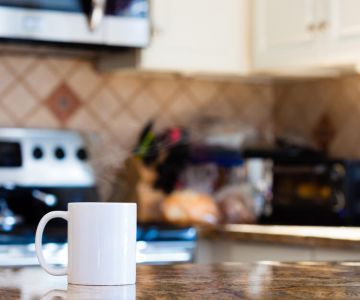<Coffee for the Average Josh, Part 3 of 10>
I got my start on coffee like a lot of people do, as a substance to wince-and-swallow like a caffeine pill before a session of late-night homework.
To be fair, some coffee tastes like steaming sludge, as if someone snuck potting soil into the filter. (Hey, it’s already been ground.)
But when I hear talk of undertones and complexities, I’m fascinated but clueless. I love the thought of poetry in a mug — ooh, and latte art! — but I’m nowhere near cool enough to distinguish my Sumatran from my Sidamo. (These are coffee-growing regions in Indonesia and Ethiopia, respectively. I am good with Google.)
So why in the world would a guy with a faulty palate want to pay anything but low-Low-LOW prices for his brew? Geesh! I never said I can’t taste anything.
But taste is only part of the equation. Here are three meaningful reasons to pay more for your coffee.
Reason 1: Exceptional coffee is carefully selected and well-traveled
Consider a single Arabica coffee tree. On an average year, it will yield 10 pounds of coffee cherries.
Once processed, this reduces to about 2 pounds of green coffee beans.
Once roasted, this reduces to about 1.5 pounds of brown coffee beans.
Once packaged, this fills the two 12-ounce bags of roasted coffee you recently tossed into your shopping cart.
What have we learned? One 5-minute trip to the grocery store for you equals one year’s production by an Arabica coffee tree. If you are an average American coffee drinker, it will take you one year to sip away the annual yield of between 12-25 coffee trees, depending on which amateur internet mathematician you believe.
Now consider:
- The best coffee is hand harvested. In order to only select ripened cherries, each tree requires three to four passes per growing season.
- The best coffee farms compensate pickers by quality as well as quantity, something that adds additional layers of complexity to a process that — on a lesser farm — is done once per year by a machine.
- The processing of cherries into green coffee beans takes multiple steps over several weeks, many of which require attentive manpower.
- Most coffee is consumed thousands of miles from where it is grown, requiring long boat rides, multiple middlemen — and occasionally nervy waits in storage containers at corruption-prone ports.
I’ve lived most of my life in Starbucks’ home state of Washington, where I’ve nurtured a craving for Honeycrisp apples grown in nearby orchards.
By contrast, I’ve probably only enjoyed a handful of cups of coffee that were grown within 3,000 miles of where I sipped them — and those were on vacation.
In honor of International Coffee Day, there was a BOGO special for a pound of one of my go-to local roasts: Thomas Hammer’s Starry Night organic.
That’s two pounds — the annual yield of 1.33 coffee trees — for $12.75.
That’s $12.75 for coffee produced by 1.33 trees growing at more than 5,000 feet elevation.
That’s 5,000 feet up in the mountains of Indonesia, approximately 8,000 miles away from the nearest Thomas Hammer.
$12.75 for, say, a month’s worth of morning happiness?
How you like them apples?
Reason 2: The birds and the bees and the flowers and the trees
Well, this just got uncomfortable.
“Josh, you’re not going to go there, are you?”
Yes. Yes I am.
I am going to talk about the environment.
Birds
Did you know that in addition to being the home of the Giant Panda Webcam — Hi Tian Tian! — the Smithsonian’s National Zoo & Conservation Biology Institute runs a “Bird Friendly” certification process for coffee growers?
Some regions have taken to carving out coffee farms from dense forests. In a Smithsonian study of bird species in Peru, these sun-drenched farms remained hospitable to 61 bird species. By comparison, “partial shade” farms support 79 species. Natural, shade-grown farms, with layers of canopies reaching as high as 35 meters? A whopping 243 species of birds can be supported there.
Bees and flowers
Smart aleck: “Arabica trees self-pollinate, so they don’t need bees.”
Dwight Schrute: “False.” (And he was a beet farmer, which is a backspace away from being an expert on the subject.)
OK, so technically Arabica trees can self-pollinate with the aid of the wind, but studies have shown that the presence of bees increases Arabica yield as much as 50 percent. Importantly, the cross-pollination efforts of bees could help increase the relative lack of genetic diversity among Arabica trees, a trait that causes scientists to worry about its long-term survival.
Look, if there is even a chance of coffee becoming extinct, someone better set me up a Giant Arabica Webcam.
Trees
OK, I’ve hinted at it long enough. What do the birds and the bees and the flowers need to thrive? It’s the trees.
And not just coffee trees. Actually, the Arabica is finicky and does best when it doesn’t grow too tall and take direct sunlight. What’s needed by all parties is a diverse ecosystem with trees of all sizes.
But here’s the rub. While shade-grown coffee plants typically produce a greater yield, sun-drenched farms allow more trees closer together.
Yep. It’s about making as much money as possible.
Endorsements and certifications on coffee such as Fair Trade, Rainforest Alliance, Bird Friendly or certified organic are among those that incentivize farmers to adopt practices that care for the environment as well as the people. Coffee carrying these certifications is typically more expensive.
Look, you don’t have to always buy coffee with a certain label, but it’s worth purchasing from places that can trace the roots of the brew. Increasingly, you can find coffee roasters that partner with specific farms, developing “single-origin” brews intent on delivering quality to the consumer as well as care for the farmers and the environment.
When I find coffee being produced with purpose and compassion, I celebrate. Not only does it typically taste better, if feels better going down.
Reason 3: Coffee is brought to you by humans, many who live in poverty
Kona coffee is among the priciest in the world.
Because of the taste? Nope. Some would argue it’s average, and very little of it is grown at the elevation typical of the world’s best coffee.
Here’s the reason: Kona is a coffee-growing region on the island of Hawaii, and Hawaii happens to be the only middle- to high-income economy in the world where coffee is a serious export.
The other coffee-producing countries are chiefly low-income economies that lie along the “Coffee Belt,” fertile lands located between the tropics of Cancer and Capricorn.
The chief reason Kona coffee costs more is that the 2020 minimum wage in Hawaii is $10.10 per hour. A coffee picker not far away in Guatemala may make more like $3 — per day.
Now let’s be real. Me paying another quarter for a cup of coffee isn’t likely to find its way into the pockets of a Guatemalan coffee farmer living in poverty. The world is unfair and sometimes corrupt.
So what can a guy without a refined palate do about it?
Look, while I may not be qualified to write flavor profiles for the packaging on my favorite roasts — sample text: “Ooh! This one pairs perfectly with my Belgian Chocolate Toffee creamer” — I can try to know where my coffee came from and support businesses who care about these things, too.
I am capable of consideration, of staring into my mug with gratitude for the far-off farms, wild landscapes and human hands that made today’s brew possible.
It’s a place to start.
Next week: “5 factors of great-tasting coffee”
This is the third in a 10-part series, “Coffee for the Average Josh,” releasing Fridays this fall. Get your fix of Coffee 101 by signing up to receive an email when the next post drops.
Previous:
- Where do coffee babies come from? (Oct. 2, 2020)
- Growing up on the coffee farm (Oct. 9, 2020)


